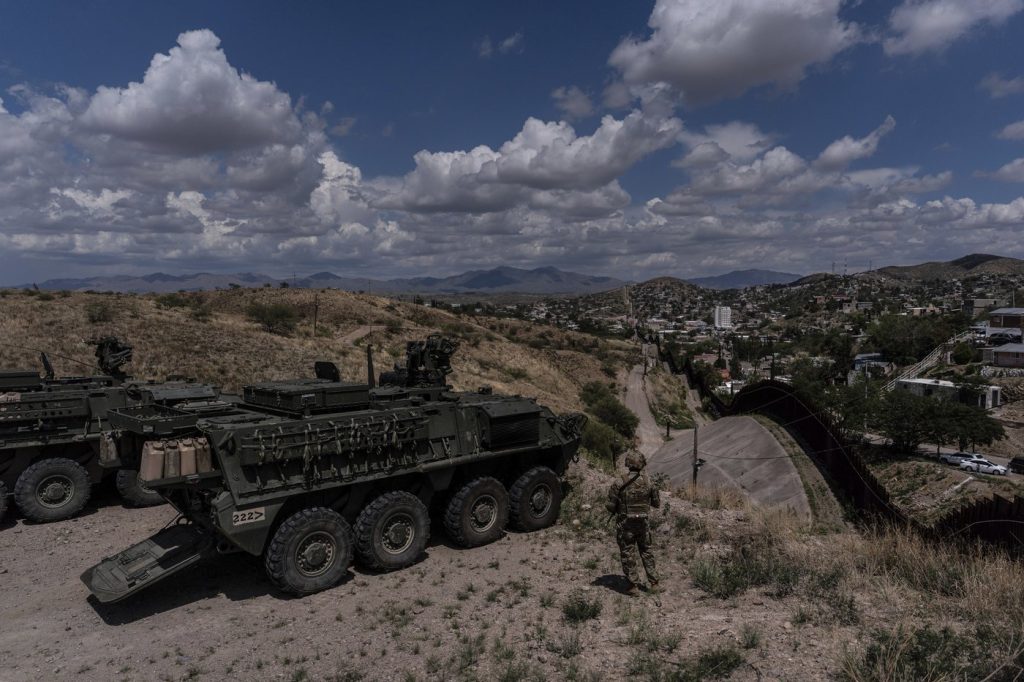NOGALES, Ariz. — An Army scout stationed in an armored vehicle utilizes a joystick to operate a long-range optical scope focused on a man atop the U.S.-Mexico border wall. As the individual begins to lower himself down into U.S. territory, alarmed shouts erupt and a U.S. Border Patrol SUV swiftly approaches, prompting the man to flee back to Mexico. This incident, occurring on Tuesday, represents one of the few sightings recorded by the Army infantry unit assigned to patrol this section of the southern border, a task emphasized by President Donald Trump's emergency declaration that positioned the military as a critical player in addressing migrant crossings.
Army Sgt. Ana Harker-Molina, age 24, articulated the tedium experienced by some military personnel due to the infrequent sightings during their patrols. Despite the monotonous nature of their mission, she expressed a sense of pride in contributing to national security, recognizing that their presence acts as a deterrent to potential crossers. Harker-Molina, who immigrated from Panama at the age of 12 and became a U.S. citizen while serving in the Army, views her service as integral to protecting the country.
The number of U.S. troops deployed along the border has surged to 7,600, involving multiple branches of the military, as illegal crossing attempts have drastically decreased. Simultaneously, Trump authorized funding for the addition of 3,000 Border Patrol agents, who will receive substantial signing and retention bonuses to bolster enforcement. The military oversight is managed from a newly established command center at an Army intelligence training base situated near the Huachuca Mountains in southern Arizona, tasked with overseeing military operations along the nearly 2,000-mile border.
The military's role marks a significant shift from past practices where border enforcement was primarily the responsibility of civilian law enforcement. A military command's designation of extensive portions of the border as militarized zones grants troops the authority to apprehend immigrants and implement extra charges that could lead to imprisonment. Army Maj. Gen. Scott Naumann indicated that personnel are being reassigned from non-enforcement tasks to collaborate closely with U.S. Border Patrol agents, providing rapid responses to high-traffic illegal crossing areas and other remote locations.
In the Nogales region, Army scouts patrol in full combat gear, equipped with M5 rifles and bullet-resistant vests, maintaining their right to use lethal force if threatened. The area has long been a target for smugglers utilizing stormwater drains to transport contraband into the U.S. Naumann's command center manages an array of military assets, which includes 117 armored Stryker vehicles, over 35 helicopters, and several drones equipped with sensors for extensive surveillance of the border.
The focus of border operations is predominantly on intercepting 'got-aways'—individuals who evade law enforcement and could potentially enter the U.S. undetected. Even as the rate of apprehensions has reached a historic low, Naumann insisted that efforts to combat illegal crossings must persist, especially as conditions may become more favorable for crossers with the end of extreme summer heat.
The military's expanded involvement raises numerous ethical and political considerations, as articulated by Dan Maurer, a law professor and former Army judge advocate officer, who described the administration’s strategy as robust and aggressive. The militarization of border zones skirts the Posse Comitatus Act of 1878, which prohibits military involvement in civilian law enforcement within the U.S., creating potential legal ambiguities.
The extension of military authority raises concerns reminiscent of past encounters, such as the 1997 incident where a U.S. citizen was killed by a Marine during an anti-drug operation, inciting backlash and ultimately leading to a halt in military border deployments at that time. Current militarized zones have also restricted public access to recreational lands, prompting discontent from local residents.
Military operations also span regions such as Mt. Cristo Rey, where Border Patrol vehicles operate in largely unfenced areas. The Defense Department recently increased militarized zones near key locations, including Texas's Rio Grande Valley, reinforcing a focus on detaining individuals crossing unlawfully from Mexico into the U.S. Soldiers utilize technology, including infrared scopes and small drones, to enhance their monitoring capabilities as they integrate their operations with Border Patrol, emphasizing a collaborative approach to border security.










